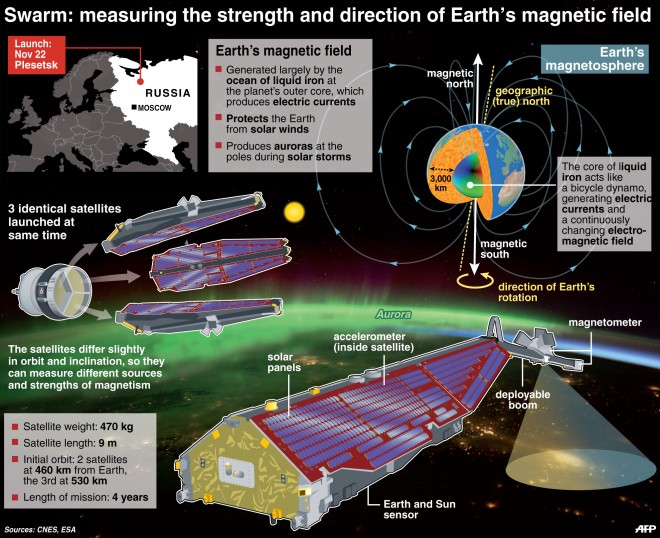PARIS – Europe next week will launch a trio of hi-tech satellites to explore something that may seem utterly mundane: Earth’s magnetic field.
After all, magnetism has been with us for billions of years.
We harness it in innumerable ways, in navigation and electrical devices. What’s new?
Well, plenty, actually.
If all goes well, the 230-million-euro ($276-million) Swarm mission will explain some of the weird things happening to the planet’s magnetism.
And they are more than just curiosities.
“Earth’s magnetic field is a very important thing. It makes life possible on Earth by providing shelter against radiation from space,” said Albert Zaglauer, project manager at Astrium, which made the three satellites.
The field is fickle, he said.
“The magnetic pole is changing, and the magnetic field is changing too. Why?”
Earth’s magnetism derives from superheated liquid iron and nickel, which swirl in the outer core about 3,000 kilometres (1,800 miles) beneath the surface.
Like a spinning dynamo, this subterranean metal ocean generates electrical currents and thus a magnetic field.
But contrary to what many may think, the field is not constant and immutable.
For one thing, the well-known gap between Earth’s magnetic north pole and its geographical north is growing.
Since 2001, the gap has been widening at the rate of 65 kilometres (40.6 miles) per year, compared with just 10 kilometres (six miles) per year in estimates in the early 1990s.
In addition, the magnetic field has been weakening. Since the mid-19th century it has lost around 15 percent of its strength.
What’s going on?
Some experts wonder if this is a prelude to something really big: a reversal of magnetic polarity.
When N becomes S
Polarity switches occur around every 200,000 to 300,000 years, according to telltale magnetic signatures found in ancient sediments.
They are believed to occur when iron atoms in lava spewed by volcanoes adopt a polarity and retain it after the rock has solidified. Eventually a planetary tipping point is reached.
“Reversals are a slow process and do not happen with any regularity,” the European Space Agency (ESA) says.
“Nevertheless, the last time this happened was about 780,000 years ago, so we are now overdue for a reversal.”
Complicating the picture is the fact that magnetism does not only come from deep within the planet.
Minerals in Earth’s crust also contribute, as do the ionosphere (between 85 and 600 kilometers or 53 and 375 miles above the Earth) and the magnetosphere, about 60,000 to 120,000 kilometers (37,500 to 75,000 miles) away.
Another contribution, albeit rather a weak one, is the sea, because salt water is conductive.
Nor is the field the same everywhere.
Scattered across South America and the South Atlantic are locations where it is weak – so much so that the lack of a shield against radiation has even affected electronics on a low-altitude satellite.
“The magnetic field is a very complex phenomenon which changes in time and space,” said Mioara Mandea of France’s National Centre of Space Studies (CNRS).
“We have identified various sources but, at a given point on the surface, they all get mixed together.”
The three satellites in the Swarm constellation, due to lift off on Friday from Russia’s Plesetsk Cosmodrome aboard a Rockot launcher, aim at tasting the magnetic soup and discerning its ingredients.
Their long, sleek design gives them a slight look of a “Star Wars” fighter.
Each 470-kilo (1,034-pound) craft is due to operate at extremely low altitudes – two will fly initially at 460 kilometers (287 miles), reduced after four years to just 300 kilometers (180 miles) – where there are lingering molecules of atmosphere.
The third will start at 530 kilometers (331 miles) to offer a different angle of view.
The satellites will each extend a four-meter (13-foot) boom on the end of which are perched instruments to measure the geomagnetic field’s strength, orientation and fluctuations.
The arm is designed to isolate the instruments as much as possible from the magnetic “noise” from the satellite’s own operational equipment – the battery, communications unit and so on.
“The biggest challenge was to deliver a product that can measure the magnetic field to extremely fine detail,” said Zaglauer.
“We have to measure (magnetic forces) in the order to 50,000 nano-teslas to within an accuracy of one nanotesla. This is unique.”
What emerges could not only unlock fundamental knowledge about the magnetic field, but also improve navigational accuracy on Earth as well as improve satellite design, he said.
